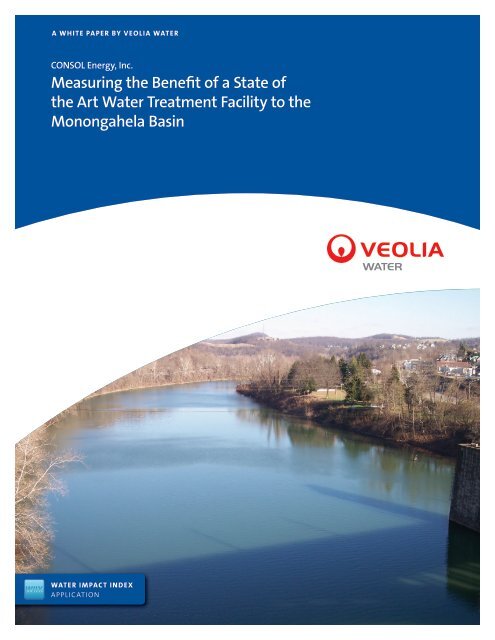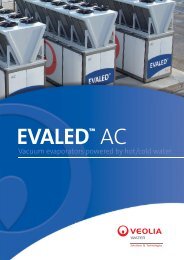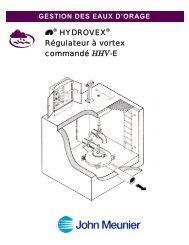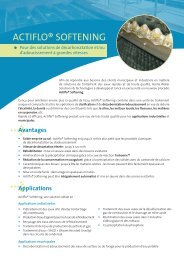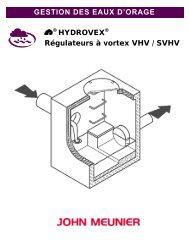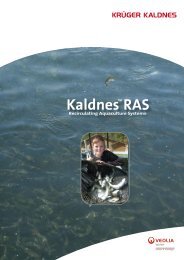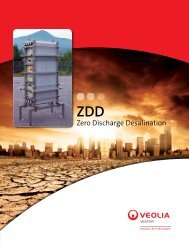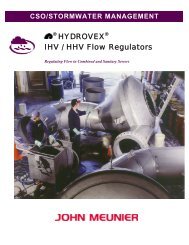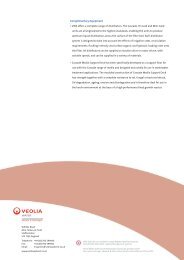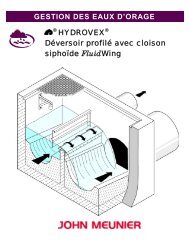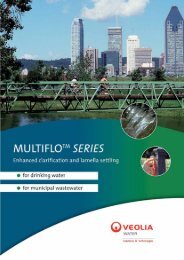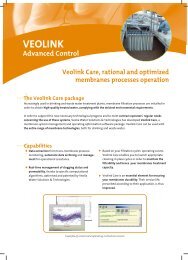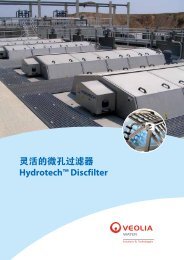An Industrial Water Impact Index case study - Veolia Water Solutions ...
An Industrial Water Impact Index case study - Veolia Water Solutions ...
An Industrial Water Impact Index case study - Veolia Water Solutions ...
- No tags were found...
You also want an ePaper? Increase the reach of your titles
YUMPU automatically turns print PDFs into web optimized ePapers that Google loves.
Innovative wastewater treatment is critical to ensuring a future with sufficientand clean water, a robust and secure economy, and an ever-improving qualityof life. These goals are only attainable if growth and improvement, and theaccompanying strain that they place on limited natural resources, is supportedwith sustainable practices.Introduction2This <strong>case</strong> <strong>study</strong> reviews how CONSOL EnergyInc., a leading energy sector company,partnered with <strong>Veolia</strong> <strong>Water</strong>, one of theworld’s leading water treatment services andtechnologies companies, to develop a state-ofthe-artmine water treatment facility.The facility integrates chemical precipitation, reverseosmosis and thermal technologies developed by <strong>Veolia</strong>to maximize the recovery of clean water for return to theenvironment. A design-build-operate project deliveryapproach is used that allows CONSOL to focus on itscore business while ensuring facility performance to thehighest standards. The result is an enhancement of waterresources in the Monongahela River basin in NorthernWest Virginia, which is the exact intent of sustainability,to protect the environment whilesupporting economic and quality oflife needs.To provide an accurate measure of thebenefit provided by the facility, the<strong>Water</strong> <strong>Impact</strong> <strong>Index</strong> was applied. The<strong>Water</strong> <strong>Impact</strong> <strong>Index</strong> is a comprehensivewater footprint indicator developed by<strong>Veolia</strong> <strong>Water</strong>. It integrates all the aspectsof the water cycle, including waterquality, water availability in the localenvironment, and volume to providean accurate measure of environmentalbenefit.This <strong>case</strong> <strong>study</strong> describesseveral elements ofCONSOL’s mine watertreatment project, includingthe treatment process, anintroduction to the <strong>Water</strong><strong>Impact</strong> <strong>Index</strong>, and theapproach used to measurethe benefit that treatmentdelivers to the MonongahelaRiver basin.A WHITE PAPER BY VEOLIA WATERRaw <strong>Water</strong>FeedTankCONSOL’s mine watertreatment facility nearMannington, West Virginia“ Partnering with<strong>Veolia</strong> on thisproject providesCONSOL with aturnkey systemcoupled withproven operatorcapabilities”– Katharine A. FredricksenCONSOL ENERGYAerationCrystallization TankClarifierAL PrecipitationSludge HoldingTankDewateringEquipmentSolidsProject DescriptionCONSOL’s mine water treatment facility is located nearMannington, West Virginia, and will treat mine waterfrom its Blacksville #2, Loveridge, and Robinson Runmines. Total design capacity is 3,500 gallons per minute(gpm) for a centralized facility. The system applieschemical precipitation, reverse osmosis and thermaltechnologies that include:• pretreatment with softening and precipitationchemistry• clarification and filtration polishing• sludge dewatering• reverse osmosis (RO) and return of the purifiedpermeate stream to the river basin• pretreatment of the RO reject with softening andprecipitation chemistry• evaporation of the softened stream and returnSolidsof the distillate to the river basin• crystallization of the brine stream• crystallizer solids dewateringThis combination of technologies results inzero liquid waste as well as solids residuals thatare safe for landfill, as shown in the block flowdiagram below. More importantly, it improveseffluent quality such that it not only meets theregulatory requirements, but leads to overallimprovement of the local water resource as willbe described below.MultimediaFilterDewateringEquipmentR.O. FeedTankR.O.EvaporatorFeed TankCrystallizationTankClarifierEvaporatorCrystalizerFeed TankCrystalizerProduct <strong>Water</strong>FinalEffluentTank
Technological innovation is not the only special aspectof this project. Cutting edge thinking also underscoredCONSOL’s approach to project execution. After reviewingmany options CONSOL selected a design build operate(DBO) project delivery approach. The approach providesa complete scope of services and maintains long termresponsibility for performance through a single solutionssupplier, in this <strong>case</strong> <strong>Veolia</strong>. The cornerstone of DBOproject delivery is <strong>Veolia</strong>’s ability to take full responsibilityfor design, installation, and performance. DBO servicesare provided to maintain performance at the designbasis, including capacity, effluent quality, availability,design build expense, operations expense, and projectschedule. On the performance end, <strong>Veolia</strong> provides adedicated management, operations and maintenancestaff providing 24/7 coverage, operations, preventiveand corrective maintenance, and chemicals and residualsdewatering. Together these commitments are deliveredthrough a performance guarantee that is contractuallysupported by <strong>Veolia</strong> for the complete term of the project.CONSOL is protected from any shortcomings in plantperformance, which are now the responsibility of <strong>Veolia</strong>.Assessing the Effect on the <strong>Water</strong> Resource:the <strong>Water</strong> <strong>Impact</strong> <strong>Index</strong>Most water footprint assessments focus on volume, avalid indicator to raise awareness but not necessarilysufficient to represent the impact on a water resource. Inthis particular <strong>case</strong>, measuring only water quantity wouldbe misleading in that influent and effluent quantities arenearly equal, as depicted below. The influent volumesare projected to be 3,505 gpm or 1.840 billion gallons peryear, and the corresponding effluent volumes are 3,490gpm or 1.835 billion. This is essentially the same amount ofwater as CONSOL currently discharges from these mines.Consequently, an assessment based on volume alone doesnot accurately reflect the benefit to the water resourcefrom this project.Recognizing that water footprint assessments based onvolume alone were no longer adequate, researchers at<strong>Veolia</strong> embarked on the development of an assessmenttool that incorporates multiple variables that areimportant to the viability of the local water resource.In addition, <strong>Veolia</strong> wanted to develop an indicator that canRecognizing that water footprint assessments based on volume alone were no longeradequate, researchers at <strong>Veolia</strong> embarked on the development of an assessmenttool that incorporates multiple variables that are important to the viability of thelocal water resource. The result of <strong>Veolia</strong>’s effort is the <strong>Water</strong> <strong>Impact</strong> <strong>Index</strong>.<strong>Veolia</strong> Integrated SolutionTreatment FacilityRaw <strong>Water</strong>FeedTankAerationCrystallization TankClarifierMultimediaFilterR.O. FeedTankR.O.Product <strong>Water</strong>FinalEffluentTankBlacksville No. 2Loveridge3505 gpmAL PrecipitationSludge HoldingTankDewateringEquipmentEvaporatorFeed TankCrystallizationTankClarifier3490 gpmRobinson RunSolidsEvaporatorCrystalizerFeed TankSolidsDewateringEquipmentCrystalizerThe results ofa volume-basedmeasurementLandfillMannington•MonongahelaBasin3A WHITE PAPER BY VEOLIA WATER
The <strong>Water</strong> <strong>Impact</strong> <strong>Index</strong>VOLUME• <strong>Water</strong> Quality• Volume ofwater used –withdrawn andreleased+STRESS• The <strong>Water</strong> Stress<strong>Index</strong>• Local conditionof resource+QUALITY• <strong>Water</strong> quality –withdrawn andreleasedbe used to support decision-making and communication,among other uses. The result of <strong>Veolia</strong>’s effort is the<strong>Water</strong> <strong>Impact</strong> <strong>Index</strong>, a comprehensive water footprintindicator that integrates all aspects of the water cycle,including water quality and availability in the localenvironment.With the <strong>Water</strong> <strong>Impact</strong> <strong>Index</strong>, the physical water quantitybalance for any product or process is weighted by a qualityindex and a water stress index, as seen above. The waterquality index provides a means of measuring changesin water quality and the value of water treatment. Thewater stress index accounts for the level of stress onthe resource. Together these factors, through the <strong>Water</strong><strong>Impact</strong> <strong>Index</strong>, provide a means of measuring the full waterimpact. Indirect impacts from the production chain suchas water use from energy, raw materials, chemicals, andwaste generation are also incorporated into the balance.The methodology is elegant in its simplicity. In essence,the <strong>Water</strong> <strong>Impact</strong> <strong>Index</strong> is a mass balance equation thatcompares the quantity, quality, and stress factor of thewithdrawn water to the same parameters of the releasedwater (see below). The equation multiplies the threevalues of volume, stress index, and quality index in thewater volume withdrawn, and then subtracts the productof the same three factors for the water volume released.There are several key points to realize in the mathematics.First, the quality index is based on a component ofconcern and the same one is used on both sides ofthe equation. Cref is a reference concentration for thiscomponent. It corresponds to the concentration thatshould be reached to ensure protection of the localwater resource for its intended uses. C is the actualconcentration of the component in the withdrawn orreleased water. Second, the stress index is a dimensionlessvalue between 0 and 1 that reflects the local scarcity ofwater. The stress index takes into consideration localwater use and availability, seasonal variations in freshwater availability and storage capacity. These values havebeen mapped for most of the world by Pfister, Zurichin 2009.The <strong>Water</strong> <strong>Impact</strong> <strong>Index</strong> is expressed in gallonsequivalent. This is a mathematical representation of thethree parameters and is not a true gallon of water. Whilethis concept can appear abstract at first, it provides anoptimal tool for decision making purposes. The lower the<strong>Index</strong>, the lower the impact to local water resources.A negative value implies that the process benefitslocal water resources. The <strong>Index</strong> can also be convertedback to actual gallons. Using this information, the userof the tool has an idea of what needs to be addressed tolower the impact.To provide the user with a better understanding of thetool, the following characteristics of the <strong>Water</strong> <strong>Impact</strong><strong>Index</strong> are provided.• <strong>An</strong> increase in the volume withdrawn increases the<strong>Index</strong>• <strong>An</strong> increase in the volume released decreases the <strong>Index</strong>• <strong>An</strong> increase in the stress index of water withdrawnincreases the <strong>Index</strong>• <strong>An</strong> increase in the stress index of water releaseddecreases the <strong>Index</strong><strong>Water</strong> <strong>Impact</strong> <strong>Index</strong>EquationStress <strong>Index</strong>Quality <strong>Index</strong>∑[WIIX = W x WSI x min [ 1; Cref l]] – j j l [ R x WSI x min [ k k ljC j,l∑k1; Cref l]] C k,lVolume WithdrawnVolume Released4A WHITE PAPER BY VEOLIA WATER
HODOLOGY• <strong>An</strong> increase in the qualityindex of the water withdrawnincreases the <strong>Index</strong>metric metric for for assessing water water impacts. impacts.METHODOLOGYirect <strong>Water</strong>mpact <strong>Index</strong>hemicalshemicals terMETHODOLOGY• A <strong>An</strong> new increase metric in the for quality assessing index water impacts.of the water released decreasesthe <strong>Index</strong>Indirect <strong>Water</strong> <strong>Impact</strong>sA new metric for assessing water impacts.Direct <strong>Water</strong>Because the methodology isrooted <strong>Impact</strong> Direct in life <strong>Index</strong> cycle <strong>Water</strong> concepts andmethodologies, <strong>Impact</strong> <strong>Index</strong>Indirect <strong>Water</strong>it also takes intoDirect WIIX <strong>Impact</strong> <strong>Index</strong>account indirect water impactsof METHODOLOGYany process from “cradle tograve.” A new Considerations metric for for indirect assessing water impacts.water Indirect impact commonly includeIndirect<strong>Water</strong><strong>Water</strong>chemicals <strong>Impact</strong> <strong>Impact</strong>and <strong>Index</strong> electricity<strong>Index</strong>consumedIndirect WIIXin the treatment process. TheEnergy Energy Chemicalscalculation is based on quality andstress indexes in the local area inDirectwhich the Direct <strong>Water</strong>electricity <strong>Water</strong> is generatedEnergy Energyor the <strong>Impact</strong> chemicals <strong>Impact</strong> <strong>Index</strong> are produced. <strong>Index</strong>EnergyChemicalsWhile calculating the direct waterChemicalsWasteimpact Chemicals is done by utilizing the<strong>Water</strong> <strong>Impact</strong> <strong>Index</strong> equation, itbecomes cumbersome to calculateall of the indirect impacts with theof the chemicals and energy used to run the plant. Thesame approach. To address this, a database of indirect variables input into the equation for the manufacture andIndirect Indirect <strong>Water</strong> <strong>Water</strong>water impact indexes is used. The calculations can be transport of chemicals assumed a West Virginia source.done <strong>Impact</strong> <strong>Impact</strong>for all steps <strong>Index</strong> <strong>Index</strong>in the life cycle of products and services The variables used for electricity generation assumed anand combined to determine a very comprehensive and Energy overall average for the U.S.EnergyEnergyEnergyinformative value.OGY Y METHODOLOGYsessing r assessing A new water water metric impacts. impacts. for assessing water impacts.ndirect <strong>Water</strong>mpact <strong>Index</strong>erexexApplying the <strong>Water</strong> <strong>Impact</strong> <strong>Index</strong> to the Mine<strong>Water</strong> Treatment FacilityThe <strong>Water</strong> <strong>Impact</strong> <strong>Index</strong> can now be applied to evaluatethe benefit of CONSOL’s mine water treatment facilityon the local ChemicalsChemicals Monongahela River basin. To begin, theboundary conditions were set to the influent that feedsand the treated effluent that is discharged from themine water treatment facility as shown on page 3. Theboundary limits provide a water withdrawn value of1.840 billion gallons per year and water released value of1.835 billion, nearly identical. The analysis uses chlorideas the component of concern in both the withdrawnand released streams; chloride is the parameter thatdrove the design of the treatment facility. The referenceconcentration used for chloride was 230 milligrams perliter (mg/l) based on a water quality standard publishedby the state of West Virginia for the protection of aquaticlife. Both the withdrawal and release occur in the samelocale in regard to stress factor index. Accordingly thesame value of 0.0229 was used on both sides of theequation. Finally, for indirect inputs, it was assumedthat the majority of the impact is related to the life cycleResults of <strong>An</strong>alysisExamining the calculation results we first see that forthe withdrawal part of the equation the direct index isrelatively small at 6.4 million gallons eq/yr., as shownbelow. This is due to the relatively low quality (highchloride concentration compared to the referenceWasteconcentration) of the water that is withdrawn. WasteMG eq/yearCalculation Results1050-5-10-15-20-25-30.8 -30MG eq/year-35-40-45-50METHODOLOGYA new metric for assessing water impacts.6.4Direct <strong>Water</strong><strong>Impact</strong> <strong>Index</strong><strong>Water</strong> withdrawn<strong>Water</strong> released-42Indirect WIIXTotal WIIX4.8<strong>Water</strong> withdrawn <strong>Water</strong> released Indirect WIIXThe net impact is -30.8 million gal eq/year,delivering a positive benefit to the environmentWasteThe lower theWIIX value,the greaterthe benefitto the waterresource.WasteWas5A WHITE PAPER BY VEOLIA WATERwww.veoliawaterna.com
Note that withdrawing water from the ecosystem alwaysincreases the <strong>Water</strong> <strong>Impact</strong> index.The calculation for water released is more telling.Although the volume is nearly unchanged betweenwithdrawal and release, the significant improvement inthe quality index dramatically reduces the direct indexto -42 million gallons eq/yr. The quality index, or ratio ofreference concentration to actual, goes from 0.15 for theinfluent water quality to a value of 1.0 for the effluent.Note that the quality index is limited to a value of oneeven if the quality of the water released is better thanthe quality required (the reference concentration), whichis the <strong>case</strong> here. Since the larger multiple is on the rightside of the equation, doing the mass balance subtractionleads to a negative value for the index. Recall that thelower or more negative the <strong>Water</strong> <strong>Impact</strong> <strong>Index</strong> thegreater the benefit to the water resource, in this <strong>case</strong>the Monongahela River basin. Finally the indirect waterimpact associated with the chemicals and electricityconsumed by the treatment facility is 4.8 million galloneq/yr, which is mostly due to the electricity used. The net<strong>Water</strong> <strong>Impact</strong> <strong>Index</strong>, depicted graphically on page 5, is-30.8 million gallon eq/yr.What does all of this mean? Recall we noted that the<strong>Water</strong> <strong>Impact</strong> <strong>Index</strong> can be converted to “real” gallons bybacking the stress index out of the equation. In doing sothe index value of -30.8 million gallon eq/yr translates toa net volume of 1.3 billion gallons of high quality waterreturned to the Monongahela River basin on an annualbasis. By installing this treatment facility, CONSOL ismaking the water available to support other uses andcontributing to an overall improvement in water qualityin the basin.Concluding SummaryIn conclusion, the objective of measuring the benefitof CONSOL’s mine water treatment facility to theMonongahela River basin has been achieved through theuse of the <strong>Water</strong> <strong>Impact</strong> <strong>Index</strong>. A simple measure of thevolume of water withdrawn and returned to the basinprovides little insight into the true benefit that treatmentprovides. To expand on existing volume-based watermeasurement tools <strong>Veolia</strong> developed the <strong>Water</strong> <strong>Impact</strong><strong>Index</strong>, a comprehensive water footprint indicator thatintegrates all the aspects of the water cycle, includingwater quality and availability in the local environment.In addition to volume, the <strong>Water</strong> <strong>Impact</strong> <strong>Index</strong> adds aquality index and local stress index to measure the impactof water withdrawn and released back into the localenvironment. The <strong>Index</strong> also takes into account indirectwater impacts associated with chemicals and electricityconsumed by the treatment facility.Using this approach, the water withdrawn for treatmenthas a value of 6.4 million gallon eq/yr in comparison to avalue of -42.0 million gallon eq/yr for the water returned.While the volume of water for both streams is roughly thesame, the improved quality of the returned water bringsmore value to the basin than the water that is withdrawn,which is of much lower quality.The indirect water impact from the use of chemicals andelectricity at the treatment facility is 4.8 million galloneq/yr which provides a net impact of -30.8 million galloneq/yr and delivers a positive impact to the MonongahelaRiver basin. The water impact can be converted backinto “real” gallons by backing out the stress indexused in the calculation, which converts the index backto 1.3 billion gallons of high quality water supplied tothe Monongahela River basin each year. The result isthat CONSOL’s Treatment Facility delivers a positiveenvironmental impact back to the Monongahela Riverbasin.With over 9,000 employees, CONSOL Energy Inc.(NYSE: CNX) is the leading diversified energy producerheadquartered in the Appalachian basin. Named one ofAmerica’s most admired companies by Fortune magazine,CONSOL Energy produces both natural gas and high-BTUcoal. Together, natural gas and coal fuel two-thirds of thenation’s power.<strong>Veolia</strong> <strong>Water</strong>, the water division of <strong>Veolia</strong> Environnement,is the world leader in water and wastewater servicesand technological solutions. Its parent company, <strong>Veolia</strong>Environnement (NYSE: VE and Paris Euronext: VIE), is theworldwide reference in environmental services. With morethan 315,000 employees, <strong>Veolia</strong> Environnement recordedannual revenues of $38 billion in 2011.Visit the company’s Web sites at:www.veolianorthamerica.comwww.veoliawaterna.comwww.veoliawaterstna.comTwitter: @veoliawaterna6A WHITE PAPER BY VEOLIA WATER


